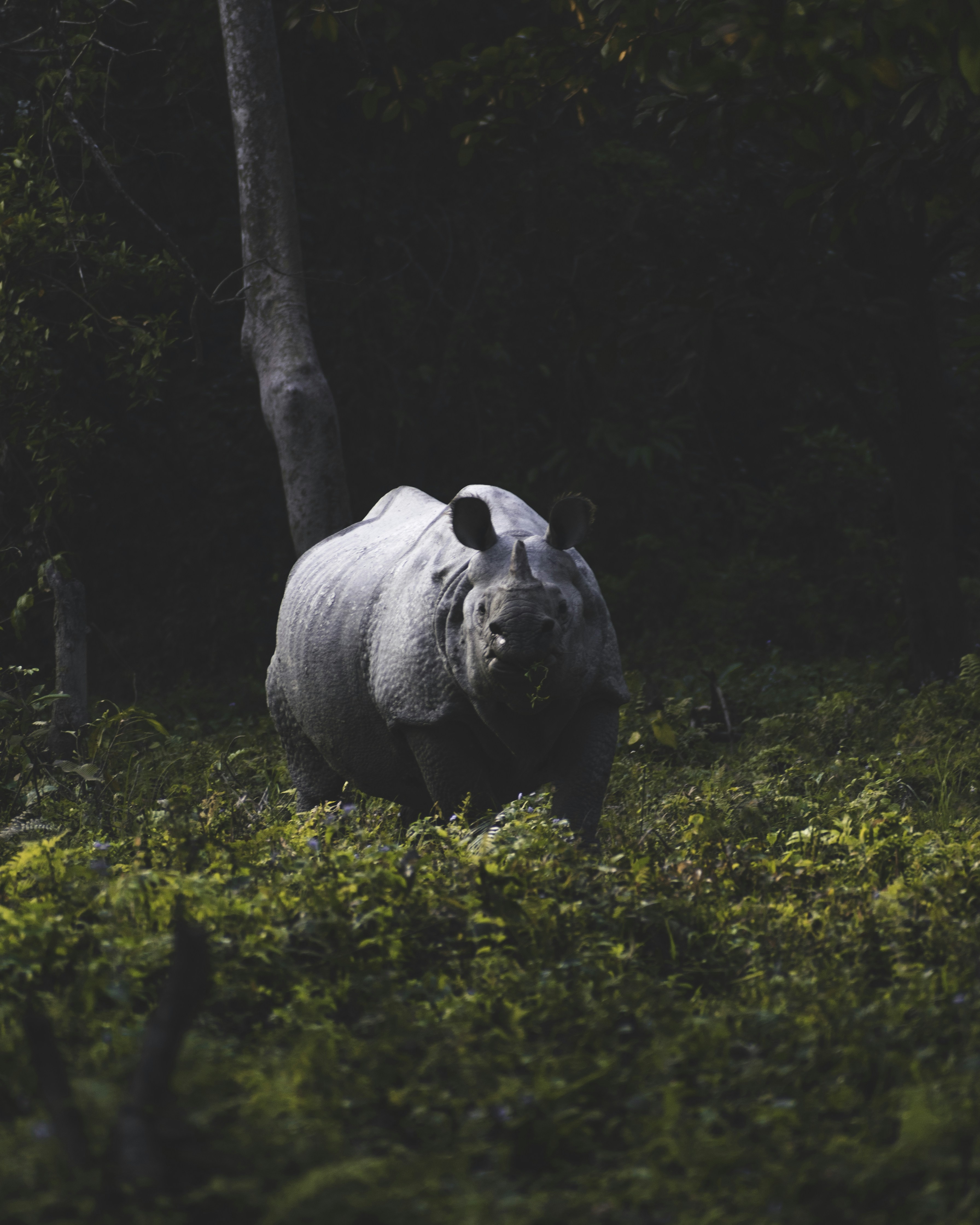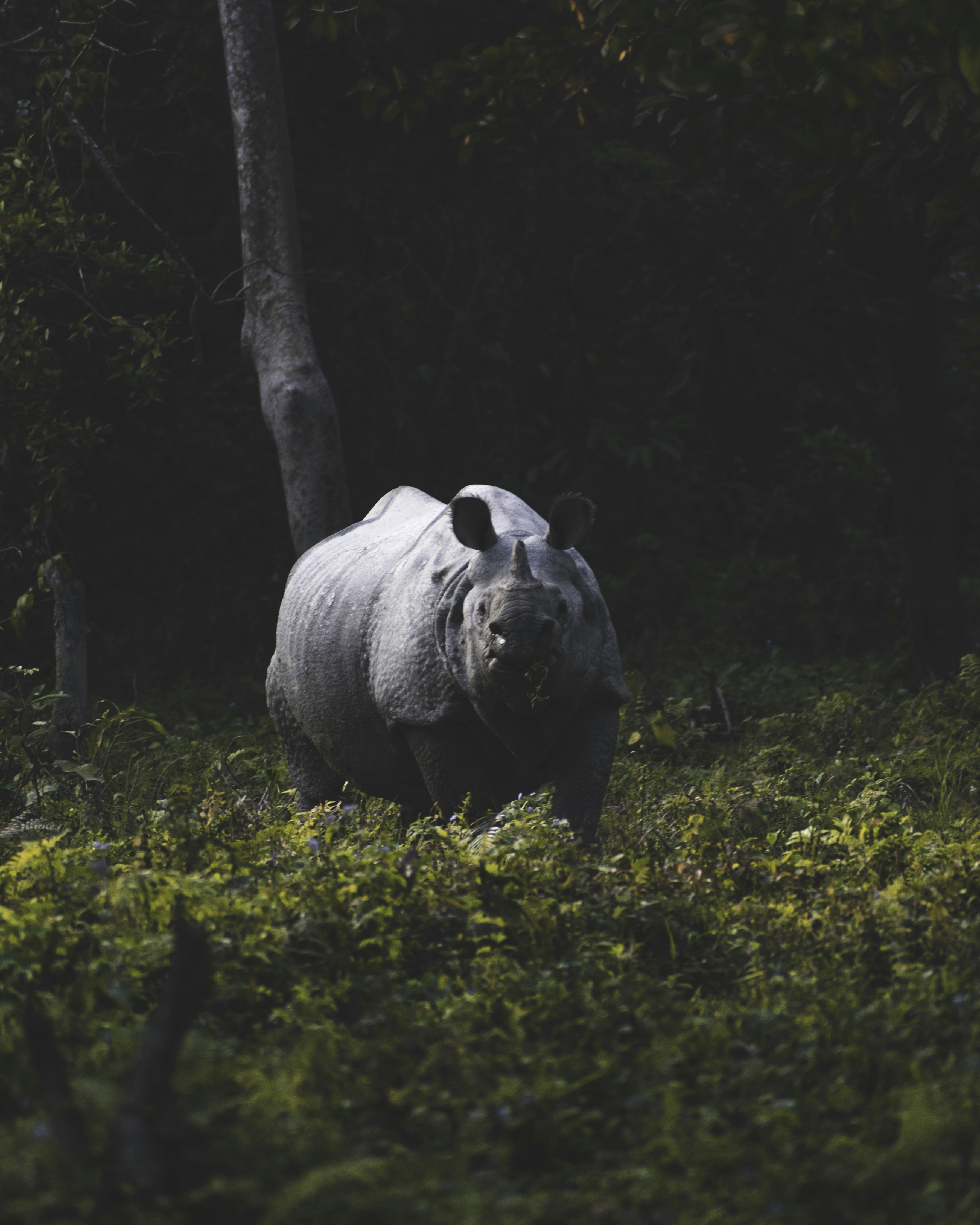The Kaziranga National Park is not only a haven for wildlife enthusiasts but also a UNESCO World Heritage Site. It is home to the largest population of one-horned rhinoceroses in the world, making it a significant conservation area for this endangered species. The park’s success in protecting and preserving the rhinoceros population has been commendable, with the number of rhinos increasing steadily over the years.
Apart from the rhinoceroses, Kaziranga National Park is also home to a wide variety of other wildlife. The park boasts a significant population of tigers, elephants, wild water buffaloes, and swamp deer. It is also a bird lover’s paradise, with over 400 species of birds, including the endangered Bengal florican and the great Indian hornbill.
The park’s landscape is a mix of grasslands, wetlands, and dense forests, providing a diverse habitat for the wildlife. The tall elephant grass, interspersed with patches of dense forests and shallow water bodies, creates a picturesque setting. Exploring the park’s different zones, visitors can witness the unique ecosystems and the fascinating interactions between the various species.
Visiting Kaziranga National Park is an adventure in itself. The park offers several options for exploring its vast expanse, including jeep safaris, elephant rides, and boat cruises. These activities allow visitors to get up close and personal with the wildlife while ensuring minimal disturbance to their natural habitat.
Conservation efforts at Kaziranga National Park go beyond protecting the rhinoceroses. The park management actively works towards preserving the overall biodiversity of the region and promoting sustainable tourism. Local communities are also involved in these efforts, with initiatives aimed at providing alternative livelihoods and raising awareness about the importance of wildlife conservation.
Overall, Kaziranga National Park is a true gem of Assam, showcasing the rich natural heritage of the region. Its success in preserving the one-horned rhinoceros population and promoting sustainable tourism serves as an inspiration for conservation efforts worldwide. A visit to this magnificent park is not only an opportunity to witness the beauty of nature but also to contribute to the conservation of endangered species and their habitats.
Not only does Kaziranga National Park provide a safe haven for the one-horned rhinoceros, but it also supports a diverse range of other wildlife. The park is home to numerous species of mammals, birds, reptiles, and amphibians, making it a hotspot for biodiversity in the region.
One of the most fascinating aspects of the one-horned rhinoceros is its unique horn. Unlike the horns of other animals, such as antelopes or buffalo, the rhino’s horn is not made of bone. Instead, it is composed of keratin, the same material found in human hair and nails. This makes the horn strong and durable, but also susceptible to poaching.
Unfortunately, the one-horned rhinoceros has faced significant threats in recent years. The demand for its horn, believed to have medicinal properties in some cultures, has led to a rise in illegal poaching. This has resulted in a decline in the population of these magnificent creatures, making conservation efforts even more critical.
Kaziranga National Park, with its dedicated team of rangers and conservationists, has been at the forefront of protecting the one-horned rhinoceros. Strict anti-poaching measures have been implemented to curb illegal hunting, and efforts are underway to raise awareness about the importance of preserving these animals and their habitat.
In addition to conservation efforts, the park also offers visitors the opportunity to observe and learn about these incredible creatures. Safari tours are available, allowing tourists to get up close and personal with the one-horned rhinoceros and witness their natural behavior in their natural habitat.
As visitors explore the park, they can also marvel at the stunning landscape that surrounds them. Kaziranga National Park is a mosaic of grasslands, wetlands, and forests, providing a diverse and picturesque backdrop for wildlife viewing. The park is also crisscrossed by several rivers, including the mighty Brahmaputra, adding to its scenic beauty.
Overall, the one-horned rhinoceros and Kaziranga National Park are intrinsically linked, with the survival of one depending on the protection of the other. Through conservation efforts and responsible tourism, we can ensure that future generations will have the opportunity to witness the majesty of this incredible species and the natural wonders of Kaziranga National Park.
Conservation Efforts
The conservation efforts in Kaziranga National Park have been instrumental in the recovery of the one-horned rhinoceros population. The park was established in 1905 as a reserve forest to protect the rhinos from rampant poaching and habitat destruction. Since then, various measures have been taken to ensure their safety and well-being.
The park is heavily guarded by forest rangers and armed guards who patrol the area to prevent poaching. Strict laws and regulations are in place to deter illegal activities, and anyone caught hunting or harming the rhinos faces severe penalties. Additionally, the park authorities have implemented community-based conservation programs to involve local communities in the protection of the rhinos and their habitat.
Another significant conservation effort in Kaziranga National Park is the successful implementation of anti-poaching measures, which have significantly reduced the number of rhinos killed by poachers. The park authorities have also taken steps to address the issue of habitat loss by creating additional grassland areas and ensuring the availability of sufficient food and water for the rhinos.
In addition to these measures, the park management has collaborated with various international organizations and research institutions to conduct scientific studies and research on the one-horned rhinoceros. These studies have provided valuable insights into the behavior, ecology, and breeding patterns of the rhinos, which have further aided in their conservation.
Furthermore, the park authorities have initiated programs to mitigate human-wildlife conflict in the surrounding areas. This includes the establishment of eco-sensitive zones and the implementation of measures to minimize crop damage caused by rhinos. By addressing the concerns of the local communities and providing them with alternative livelihood options, the park management has successfully reduced conflicts between humans and rhinos, ensuring the long-term survival of the species.
Education and awareness programs are also an integral part of the conservation efforts in Kaziranga National Park. The park authorities have been actively involved in educating visitors, local communities, and school children about the importance of wildlife conservation and the need to protect the one-horned rhinoceros. These programs aim to foster a sense of responsibility and ownership among the stakeholders, encouraging them to actively participate in the conservation efforts.
Overall, the conservation efforts in Kaziranga National Park have been multi-faceted and comprehensive, addressing various aspects of rhino conservation. Through strict law enforcement, community involvement, habitat management, research, conflict mitigation, and education programs, the park management has successfully protected and revived the one-horned rhinoceros population, making Kaziranga National Park a shining example of successful wildlife conservation.
One of the key factors contributing to the incredible wildlife diversity in Kaziranga National Park is its unique geographical location. Situated in the northeastern state of Assam in India, the park is nestled between the mighty Brahmaputra River and the Karbi Anglong hills. This strategic positioning creates a variety of habitats within the park, ranging from grasslands to wetlands to dense forests.
The tall elephant grass, which covers a large part of the park, provides an ideal hiding place for the park’s most iconic resident, the one-horned rhinoceros. These majestic creatures can often be seen grazing peacefully in the grasslands, their massive size and distinctive horn making them a sight to behold.
As you venture deeper into the park, you’ll be greeted by the enchanting melodies of the park’s avian inhabitants. The wetlands, with their shallow waters and abundant vegetation, attract a wide array of migratory birds. During the winter months, flocks of birds from as far as Siberia make their way to Kaziranga, seeking refuge from the harsh cold weather in their breeding grounds. The park becomes a symphony of bird calls, with vibrant plumage and graceful flights adding to the visual spectacle.
But it’s not just the birds that call Kaziranga home. The park is also a sanctuary for several endangered mammal species. The elusive Bengal tiger prowls through the dense forests, its distinctive stripes blending seamlessly with the dappled sunlight filtering through the trees. Elephants, with their gentle demeanor and imposing presence, can be spotted gracefully navigating their way through the park’s diverse terrain. Wild buffaloes, known as water buffaloes, often gather near the park’s water bodies, seeking respite from the sweltering heat.
However, it’s the smaller creatures that often go unnoticed but play a crucial role in maintaining the delicate balance of the ecosystem. The park is home to a plethora of insect species, including butterflies of all shapes and sizes, beetles, and bees. These tiny creatures, with their intricate patterns and vibrant colors, are essential pollinators, ensuring the survival of the park’s diverse flora.
Overall, Kaziranga National Park is a testament to nature’s resilience and the importance of conservation efforts. Its rich wildlife diversity serves as a reminder of the intricate web of life that exists within our planet, and the need to protect and preserve these fragile ecosystems for future generations.
Visiting Kaziranga National Park
Kaziranga National Park offers a unique wildlife experience for visitors. The park is open to tourists from November to April, with the best time to visit being February and March when the weather is pleasant, and the animals are easily spotted.
Visitors can explore the park through jeep safaris, elephant rides, or even by boat, depending on their preferences. The park authorities have designated specific routes for safaris to ensure minimal disturbance to the wildlife and their habitats.
It is essential to follow the park’s rules and regulations while visiting to ensure the safety of both the visitors and the animals. This includes maintaining a safe distance from the wildlife, refraining from littering, and avoiding any actions that may disrupt the natural environment.
When embarking on a safari in Kaziranga National Park, visitors are in for a treat as they witness the diverse range of wildlife that calls this park home. The park is renowned for being the habitat of the one-horned rhinoceros, which is a critically endangered species. In addition to the rhinoceros, the park is also home to other iconic animals such as tigers, elephants, wild water buffaloes, and various species of deer.
During the safari, visitors may also come across a myriad of bird species, making Kaziranga National Park a paradise for birdwatchers. The park boasts over 500 species of birds, including the endangered Bengal Florican and the Great Indian Hornbill.
Aside from the wildlife, Kaziranga National Park is also known for its breathtaking landscapes. The park is situated in the floodplains of the Brahmaputra River, which creates a unique ecosystem that supports a wide range of flora and fauna. The park is dotted with tall elephant grass, marshes, and shallow ponds, creating a picturesque setting for visitors to immerse themselves in nature.
In conclusion, Kaziranga National Park is a treasure trove of biodiversity and a sanctuary for the one-horned rhinoceros. The park’s conservation efforts have played a vital role in protecting and preserving this majestic species, making it a must-visit destination for wildlife enthusiasts and nature lovers. Whether it’s the thrilling wildlife encounters, the stunning landscapes, or the opportunity to contribute to conservation efforts, a visit to Kaziranga National Park is sure to leave visitors with unforgettable memories and a deep appreciation for the wonders of the natural world.
Enter your email to get the Latest Updated Exploring News and Topics
Discover more from atozexplore.com
Subscribe to get the latest posts sent to your email.







